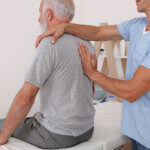Arthritis-related neck pain is a frustrating condition that can limit your everyday activities. It’s caused by inflammation or the breakdown of cartilage in and around the spine, causing the bones to rub together painfully. Arthritis can inflame different areas of the neck, including the facet joints of the spine and even the places where ligaments and tendons connect to the spine. Another symptom of arthritis-related neck pain is bone spurs, which are overgrowths on the edges of bones. All of these things decrease flexibility and make it more difficult to maintain fine motor skills.
Symptoms of arthritic neck pain
How do you know if the pain you’re feeling is from arthritis? Here are a few of the leading symptoms that may indicate that you have arthritis-related neck pain:
- Chronic pain in the neck and shoulders.
- The sound or sensation of popping during neck movement.
- Involuntary muscle contractions or spasms that trigger pain or temporary loss of movement.
- Decrease in flexibility.
- Increased stiffness and tenderness.
- Numbness or weakness in arms, hands or fingers.
If you are experiencing persistent or worsening neck and shoulder pain symptoms, you should seek medical attention.
Causes of arthritic-related neck pain
The direct cause of arthritic neck pain is often unidentifiable. However, both genetic and environmental factors do come into play. Some causes include:
- Poor mechanics — Repetitive motions or poor posture can increase your chances of developing arthritis by putting unnecessary strain on specific joints or ligaments.
- Coexisting conditions — Some people are predisposed to arthritis due to diseases they already have. These include diabetes, gout, psoriasis, tuberculosis, irritable bowel syndrome and Lyme disease.
- Infection — Germs traveling through the bloodstream can also cause an infection called septic arthritis. Knees are the most commonly affected joints, but it can occur in other areas, including the shoulders and spine.
- Age — Osteoarthritis is the result of general wear and tear on the body and is common for those over the age of 60. Through aging, the cartilage between joints wears down with use, causing inflammation and pain.
- Injuries — Though spinal arthritis usually progresses over a number of years, it can be triggered by a sudden injury, such as a fall or strain from heavy lifting.
No matter the cause of your arthritis neck pain, physical therapy is a valuable resource for patients who want to regain mobility and live with less pain.
How to manage arthritis
While the symptoms of arthritis-related neck pain may be mild at first, they should not be ignored. Neck pain can be a contributing factor to other conditions. If ignored, it may only grow worse and can even affect things like balance or fine motor skills. Though there is no cure for arthritis, working with a physical therapist can help you manage symptoms and improve your quality of life.
Physical therapy is made up of two types of treatment: active modalities and passive modalities. The physical therapy modalities your physical therapist uses depend on a number of factors, including the severity of your condition and your goals. Your physical therapist can evaluate your condition and assess your needs to develop a tailored treatment plan that is right for your arthritis neck pain.
Active modalities for arthritis neck pain
Research has shown that physical therapy patients receive both short-term and long-term benefits. Exercises that you perform yourself are active modalities that can help with flexibility and overall strength. Active modalities include:
- High-intensity exercises.
- Specific stretches and exercises contributing to control, mechanics and mobility.
PT stretches and exercises can make daily tasks easier on your body. They can help you improve mobility and strengthen your muscles.
Passive modalities for arthritis neck pain
While physical exertion can help mitigate pain, there are other physical therapy options that can help as well, such as passive modalities. Passive modalities are therapies that are performed on you. Some commonly used passive PT modalities include:
- Manual therapy — Manual therapy techniques, such as soft tissue mobilization, can be very effective for those dealing with arthritis neck pain. Your physical therapist will use their hands to manipulate the muscles and ligaments in your neck and the surrounding areas, which can improve your neck’s mobility and help with pain reduction.
- Transcutaneous electrical nerve stimulation (TENS) — TENS uses electrodes that trick the brain into feeling less pain. Electrical stimulation can decrease pain, muscle spasms, inflammation and soft tissue edema.
- Superficial heat — By going deep into the tissue, superficial heat reduces swelling and inflammation. This method is done at home.
- Cryotherapy or ice packs — These can help with swelling, pain and reducing local metabolism. This method is done at home.
Passive modalities are often used in the same recovery plan as active physical therapy treatments. These treatments are administered with the goal of decreasing pain levels and making everyday life easier.
Get treatment for your arthritis
Here at Peak Performance, we understand how frustrating it is to be limited by chronic arthritis neck pain. Don’t wait until your condition worsens. Our team of expert physical therapists are ready to help you decrease your pain levels and increase your quality of life. Whether the plan we create for you uses active modalities, passive modalities or both, working with one of our physical therapists can help you manage your arthritis-related neck pain better and reduce your limitations day to day. Get a consultation with our certified and skilled physical therapists today.
Call us or request an appointment today to see how you can start working toward less arthritis-related neck pain.







